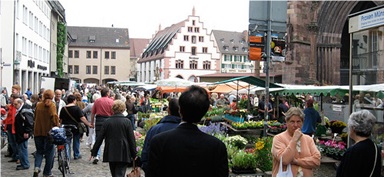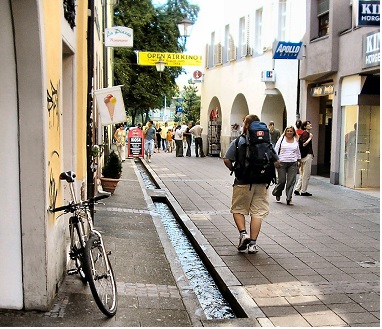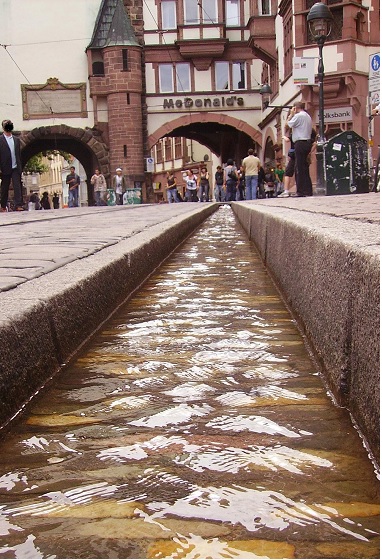Appendix E - Spatial Content & Process Principles
E.1 Diversity, Safety & Tolerance
• Encouragement of a balanced age and social profile within the New Quarter.
The provision of facilities in public and private infrastructure for all generations with the provision of well-managed places balanced with free spaces.
• The provision of a full range of facilities, especially for all ages.
• The integration of all strands of society irrespective of ethnicity, gender or age.
E.2 A new neighbourhood for Kilkenny
• Decentralised governance is of particular importance in: residential living and working, social infrastructure, education and culture, recreation and management of green spaces and networks.
• The protection of Kilkenny’s identity is a precondition for sustainable urban planning and development.

“Great neighbourhoods emerge when individuals have a sense of pride and their neighbours have a collective responsibility for the quality of the places where they live, work and visit.”
Kevin McGeough, Academy of Urbanism
E.3 Kilkenny, a city of short distances
• Existing facilities should be enhanced and new ones introduced in such a way that they are in accordance with the concept of the Compact City
• Accessibility to all infrastructure networks on foot minimises car traffic and leads to an improvement in environmental quality.
• The development of public transport and shuttle services should be given priority over the use of private motor vehicles.
• New pedestrian and bicycle network to be established linked to the existing City Network.
E.4 Public transport and density
• Kilkenny’s public transport should be closely integrated with the urban design vision and, as a general principle, must always be given priority.
• The urban density of the New Quarter should be brought about in a sensitive and sustainable manner.
• Land uses with civic function and high frequency of use should be located in close proximity to public transport and shuttle nodes in order to increase urban intensity.

E.5 Education, science and culture
• Schools and universities, research facilities and cultural institutions make a significant impact on the attractiveness and the quality of a city. They have a strong influence on public life and can have a decisive influence on the planning culture of a city.
• Kilkenny has to create opportunities for personal development and life-long learning.
• Kilkenny, having had a Charter granted by James II for the University of St. Canice in 1689, has all the attributes of a city in which a third level college, research facilities and cultural institutions are based.


E.6 Industry, enterprise and jobs
"Kilkenny is a sustainable city because it has Understood its past and its citizens appreciate how that fits with its future”
- The most important task for the future of Kilkenny is the conservation of existing employment and the development of innovative knowledge based businesses.
- The former Smithwick’s Brewery site presents the opportunity to counteract the trend to greenfield development and ‘edge city’ with a concentration on the regeneration of existing urban fabric.
- The Brownfield former brewing site, located in close proximity to the medieval High Street and Parliament Street, is an ideal site, if properly planned and marketed, for the location of Creative Industries, Research & Development and Cultural Facilities.
E.7 Nature and environment
- The conservation of biological diversity, the wise use of resources for the benefit of future generations and the protection of a healthy and liveable environment are key objectives for urban development.
- All areas of planning have to be evaluated for their impact on the environment prior to implementation, in order to safeguard the habitats of animals and plants as well as historically-important cultural landscape.
- The new Noreside Park, the opening up of public parks along the Breagagh River, the creation of new recreation areas, in addition to new squares and public spaces is a significant contribution to the quality of the public realm of Kilkenny.
E.8 Design quality
- The planning decisions on the Smithwick’s Brewery / Bateman Quay site will shape the appearance of Kilkenny for generations. These decisions must therefore support and enhance the character of Kilkenny by promoting the highest qualities of design.
- Public spaces will play a key role: together with their neighbouring buildings they will form the public face of this new Quarter in Kilkenny.
- The development of key building projects has to be led by the planning authority from initial concept through to realisation on the ground.
- Tools such as architectural design competitions, and expert panels, should be employed as a general principle, in order to find solutions for important buildings and public spaces.
- The structure of the plot plan – as a starting point for diversity – plays a very important role.
- Processes of urban redevelopment will be of special importance in determining the successful future of the site.
E.9 Long term vision
- Consistent urban planning and development of needs to follow a unifying vision that refers back to the city’s past and projects forward several generations.
- The city must not be submitted to short-lived fashions or political whim. Additions to cities that have evolved over historical timeframes must anticipate the needs of future generations, conserving the old and celebrating the new. Only in this way can the uniqueness and the character of a Kilkenny, maintained and enhanced.
- Continuity, quality and awareness of the intricacies and genius loci of a site are important attributes for a sustainable future for Kilkenny.
"This new urban quarter in Kilkenny integrates water and landscape within both the historic spine of High Street and Parliament Street and the proposed new development simultaneously improving quality of life and reducing energy demands”
Prof. Brian Evans, University of Glasgow

E.10 Communication and participation
- Communities must work continuously on their collective vision for the city through public discourse that becomes manifest in public spaces and in city culture.
- Continuous communication will be supported among the protagonists and stakeholders inside and outside Kilkenny’s administration. The outputs should be fed directly into planning processes to help create transparency and to inform political decisions.
- All Kilkenny’s Citizens will be invited to participate and engage through appropriate modes of communication – in all phases of development from initial visioning and Masterplanning through to detailed planning, delivery and management.
- A culture of engagement will be established, employing a wide range of techniques available to Kilkenny County Council as demonstrated by the extensive public consultation in the preparation of this masterplan.
E.11 Reliability, obligation and fairness
- A citywide concept, with principles of consensus, creates the proper environment within which all the participants in urban regeneration projects can act with equal rights.
- In order for Kilkenny to become a reliable partner for all citizens and investors, urban policy will be founded on basic resolutions that have a binding effect on the city administration.
- Basic principles will govern site development guidelines and standards of sustainable construction. These principles should be made legally binding through development masterplans.
- A level of trust & communication will be created within Kilkenny’s administration and citizens in relation to the new Kilkenny Noreside Masterplan with sufficient freedom to enable innovation and creativity to flourish.
“Nothing beats real citizen involvement in the planning of sustainable cities!” Frank McDonald, Academy of Urbanism, Environment Correspondent, Irish Times
E.12 Co-operation and partnership
- Co-operation and participation between local authority and citizens serve to distribute and share the burden of complexity of urban planning and development.
- Financial support for projects from the European Union, Irish Government and Energy Research Institutions can create incentives for investors and can also serve to guide them in implementation.
- The exemplary action by Kilkenny Borough & County Councils with regard to the initiatives in preparing an Urban Design Framework and Masterplan for the former Smithwick’s Brewery site.
- Agreement with stakeholders, the support of citizen commitments, all make wide-ranging urban redevelopments processes possible and more successful and sustainable.
- Scientific institutions, universities, industry and professional bodies are important players in innovative urban development.
Reference:
With thanks to the Academy of Urbanism and the City of Freiburg, Germany, which produced the following a study Town and discourse produced “The Freiburg Charter for Sustainable Urbanism”
This Charter advocates good practice in Sustainable Urbanism and has been a guide in producing this Masterplan
